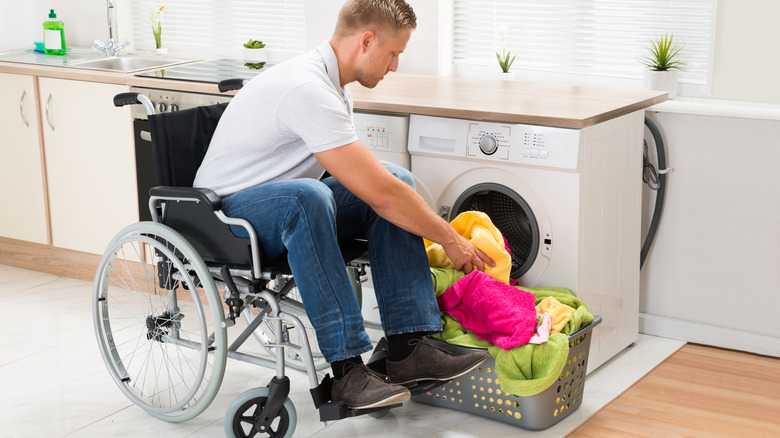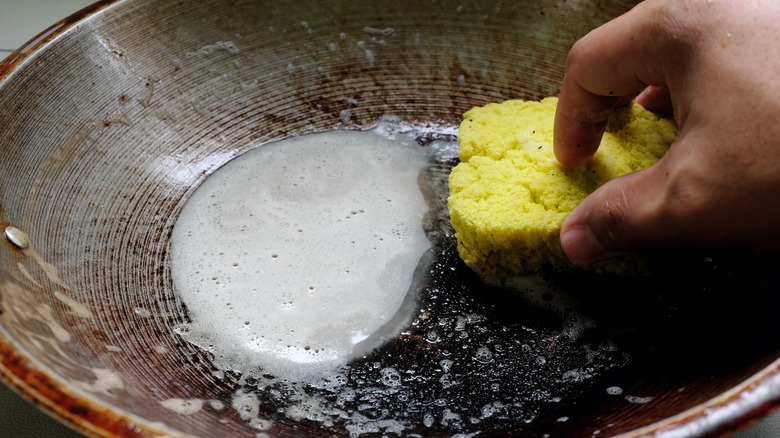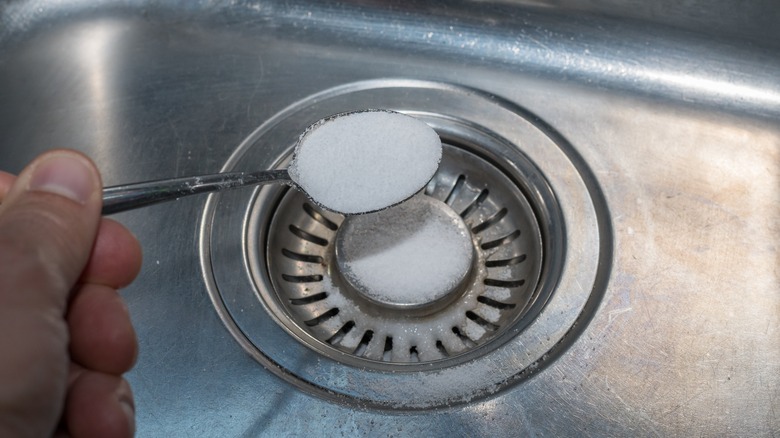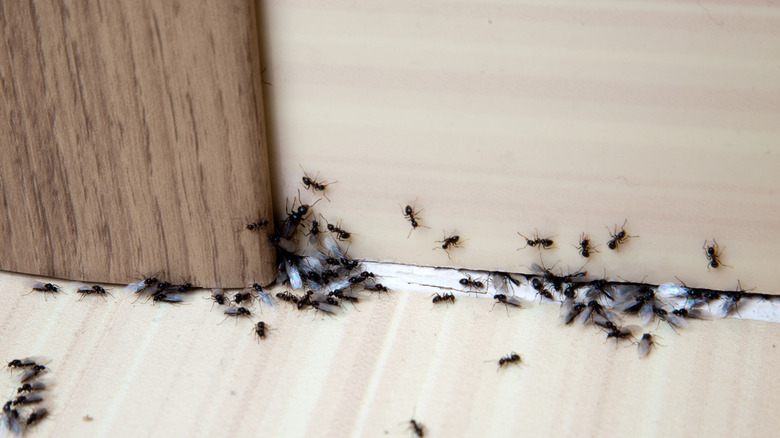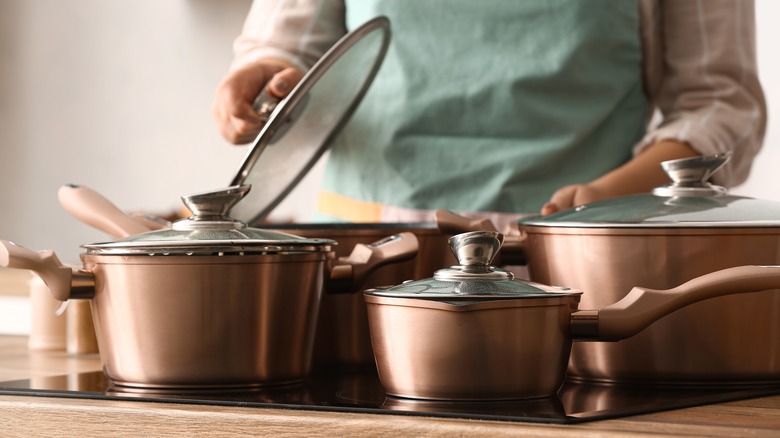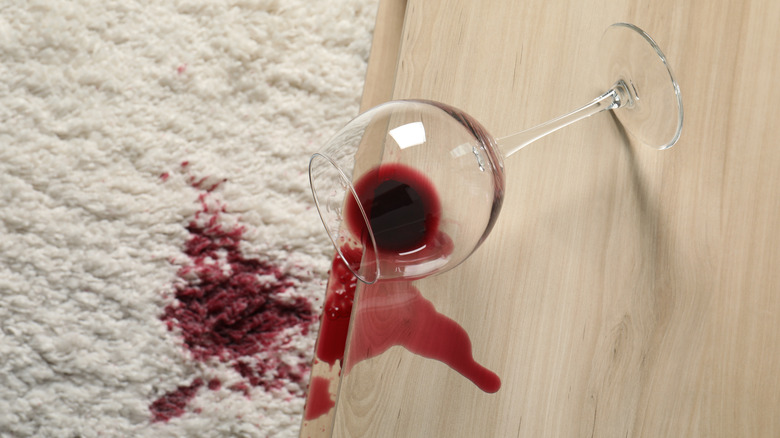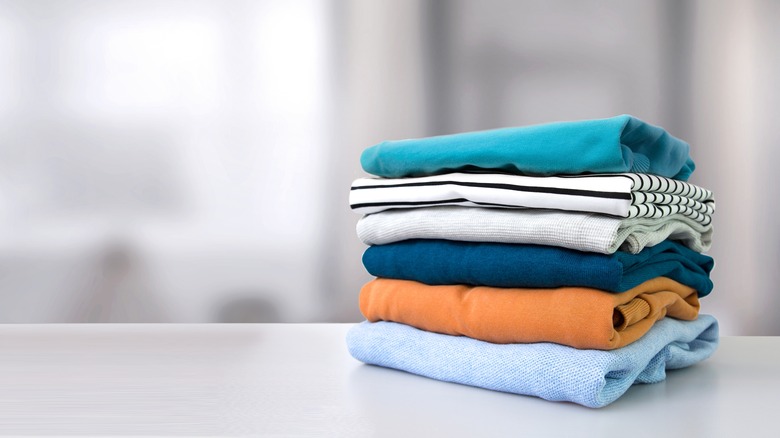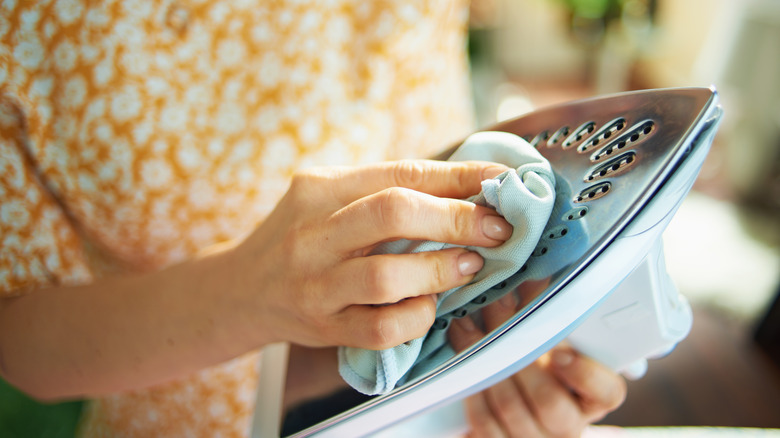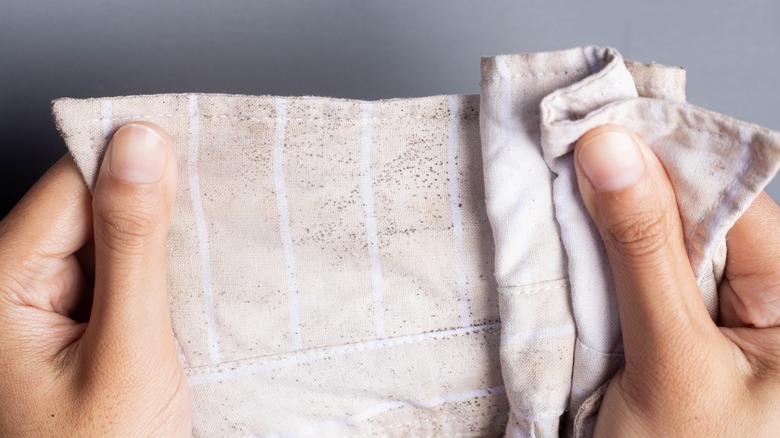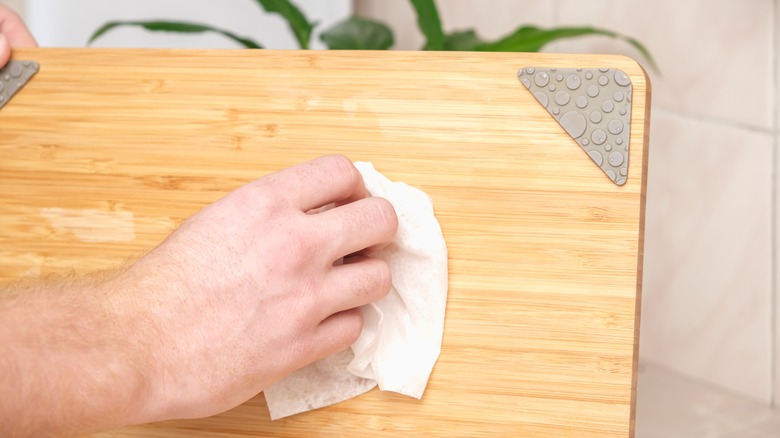All The Clever Ways You Should Be Using Salt When Cleaning Your Home
Salt, that simple ingredient you sprinkle on your fries, holds a surprising secret that transforms it into a cleaning powerhouse. Its effectiveness is not just folklore; there's genuine science behind why salt can be your go-to for a variety of cleaning tasks. Salt is essentially sodium chloride, a mineral compound found abundantly in nature. It's harvested from salt mines or by the evaporation of seawater and other mineral-rich waters. This process leaves behind crystalline granules that are versatile in the kitchen and beyond.
The secret to salt's cleaning prowess lies in its abrasive texture. When you use salt to scrub surfaces, its small, hard particles can dislodge dirt and grime in a way that's both effective and, importantly, natural. But it's not just about physical abrasion; salt has properties that also make it a mild disinfectant. It can draw out moisture from bacteria, causing them to dehydrate and die, which is why it has been used for centuries, not just in food preservation but also in cleaning and disinfection.
Salt has antimicrobial properties, making it effective in inhibiting the growth of certain bacteria. This research highlights salt's role not just as a culinary ingredient but also as a valuable tool in maintaining hygiene and cleanliness in our homes and environments. This dual function of salt, both as a physical scrubber and a microbial inhibitor, underscores its utility beyond the dining table, making it a surprisingly versatile ally in household cleaning.
As a grease stain remover
Diving into the world of unconventional cleaning hacks, let's kick things off with salt's surprising prowess as a grease stain remover. If your pots and pans are left with stubborn grease stains that refuse to budge, salt might help. Here's a handy trick to tackle those greasy offenders. Add some warm water to the affected pot or pan; the warmth from the water will help to soften the grease, making it more susceptible to treatment. Stir in 2 tablespoons of salt, and let this concoction sit quietly overnight, allowing the salt to work its magic. As dawn breaks and you're ready to face the day, introduce an additional tablespoon of salt to the mix. Now, gently heat the pot or pan until the water begins to boil. This combination of warmth and salt acts as a gentle yet powerful detergent, cutting through the grease with remarkable efficiency.
This is thanks to salt's ability to attract and absorb water molecules from its surroundings. So, when you apply it to a grease stain, it doesn't just sit there; it actively draws out the moisture from the grease, pulling it away from the surface it clings to.
As a drain cleaner, when mixed with vinegar
Moving on to another clever use of salt in your cleaning arsenal, let's now discuss a common household headache: clogged drains. Before you call in the professionals or resort to chemical drain cleaners, why not give salt a chance to shine? If it works, you'll also save potential plumbing fees associated with the task. To tackle those pesky clogs, whip up a solution using equal parts salt and water. The trick here is to heat this mixture until it's just shy of boiling. The warmth amplifies salt's natural properties, making it a formidable foe against blockages. Once your solution is ready, carefully pour it down the troublesome drain.
As mentioned earlier, salt has a knack for breaking down grease and emulsified fats. These are a common cause of drain clogs. This effect is significantly enhanced when you introduce vinegar and hot water into the mix, creating a dynamic cleaning trio. The hot water helps to melt away the grease, while the vinegar — with its acetic acid — dissolves the clog further. When salt joins the party to unclog your drain, it acts as a catalyst, boosting the breakdown process and leading to clearer pipes. It's not a one-and-done deal, though; for optimal results, repeat the process a few times. After you've given the saltwater enough time to work its magic, conclude the procedure with a flush of cool water. This final step helps to clear out any loosened debris, ensuring your pipes are as good as new.
To help deter certain ant species
Stepping into the world of natural pest control, we'll now explore how salt can also play a pivotal role in deterring ants. There are two primary ways to use salt when battling these tiny invaders. Firstly, you can create a solution by dissolving a good amount of salt in water. You can then apply the concoction directly to the ants. The theory here is that the salt, through its osmotic effect, may lead to dehydration in ants, potentially killing them. The second strategy harnesses the power of dry, plain table salt as a barrier. You can sprinkle the salt across entry points or paths that ants frequent to create a line of defense that the insects are hesitant to cross. This method may be particularly useful for minor ant issues rather than a full-blown infestation.
One caveat is that some ant species prefer salt over sugar. So it helps to know which ants you're dealing with. It's also worth noting that while many homeowners swear by the efficacy of salt against ants, the scientific backing remains largely anecdotal. There's a suggestion that salt may harm certain species of ants by affecting their ability to retain moisture and possibly impacting their respiratory system. Yet, definitive evidence remains elusive. If the ant infestation is too much, you might want to use other, more effective methods or hire a local pest control company.
As a copper and brass polisher, when combined with vinegar
If you want to maintain the beauty and luster of brass and copper items in your home, salt emerges yet again as a surprisingly effective tool. It's fascinating how this common kitchen ingredient can be repurposed to remove tarnish and breathe new life into metals that have lost their sparkle. For brass items that have seen better days, a straightforward solution exists that doesn't require any special equipment or harsh chemicals. Begin by mixing 3 tablespoons of salt into a pint of vinegar. This concoction should then be transferred into a spray bottle for easy application. Generously spray the solution onto the tarnished brass, allowing it to sit for a bit. This waiting period gives the solution ample time to penetrate the tarnish. Afterward, a soft cloth can be used to gently rub the surface clean.
Turning our attention to copper pots, which are prized for their beauty and heat conductivity in the kitchen, salt offers a similarly effective remedy for tarnish removal. Cut a lemon in half and dip the cut side into salt, using it as an abrasive pad. Rub this directly onto the tarnished areas of your copper pots. The salt serves as a gentle scrub, while the citric acid in the lemon juice aids in dissolving the tarnish. The acidity of the vinegar, combined with the mild abrasiveness of the salt, works wonders in lifting away the tarnish, revealing the brass' original shine.
To remove wine stains on fabrics
For many of us, discovering a red wine stain on our carpet can be a moment of panic. Yet, before you start worrying about permanent damage, salt emerges as a simple, effective solution that can help tackle red wine stains in a way that's safe for your carpet. But you need to act quickly because wine, particularly the red type, contains a high content of tannins and chromogens, which make very effective natural dyes that readily bond with fabric fibers. Waiting too long allows the stain to bond to the fabric. To clean, use a paper towel and gently blot the stained area to remove as much of the wine as possible. The key here is to blot, not rub, to avoid pushing the stain further into the carpet fibers. Once you've blotted as much wine away as you can, it's time to bring out the salt. Cover the entire stain with a generous amount of salt, ensuring that the wine is completely obscured. This is where patience plays a role. You'll need to give the salt sufficient time to absorb the wine.
As the salt absorbs the wine, it expands, pulling the stain out from the depths of your carpet fibers and trapping the moisture within its granules. Once the salt has completely dried, a final step remains. Simply vacuum over the stained area, removing the dried salt along with the last remnants of the red wine stain.
To prevent clothes from fading
Have you ever experienced the disappointment of washing a new, vibrant piece of clothing, only to see it lose some of its luster? It turns out the solution to this common problem might be as simple as reaching for the salt in your kitchen. Apparently, adding 1/2 cup of salt to your wash does wonders in preserving the color of a new garment during it first wash.
Clothes fade over time due to the breakdown of dyes, plus the wear and tear from washing and exposure to sunlight. Each time you wash your garments, the water and detergent gently erode the fabric's fibers, releasing dye particles. Harsh detergents, bleach, and even some cycles of the washing machine can exacerbate this process. Additionally, sunlight has a bleaching effect due to its ultraviolet (UV) light, which breaks down the chemical bonds in the dye, leading to fading. When you introduce salt to the washing process, particularly with new clothing, you're employing a time-tested technique to lock in the fabric's dye. The salt acts as a color fixative, reducing the likelihood that the dye will wash out and lead to a faded appearance. This is especially crucial during the initial wash. You might find this method particularly useful with natural fibers — like cotton — that tend to lose color quickly.
To clean an iron
When keeping your iron in tip-top shape, a little kitchen chemistry using salt can go a long way. Make sure you unplug your iron before starting the cleaning process. Begin this cleaning ritual by blending salt with just enough water to create a paste. Using a soft cloth, gently apply this mixture across the entire stained or dirty area of the iron's soleplate. Letting the paste sit momentarily allows the salt to start breaking down the dirt and oils. After that, wipe the soleplate dry. Once fully dried, switch on the iron and heat it on the high setting for a few minutes. Using a soft cloth or sponge (and keeping your hands fully protected by the cloth or oven mitt), use circular motions with sufficient pressure to eradicate all the grime from the soleplate. Conclude the process by wiping the soleplate clean, ensuring it's free of any salt residue.
This method is particularly effective because the salt in the paste acts as a gentle scouring agent. When heated, the accumulated residues are easier to remove. However, it's paramount to remember that safety comes first. Salt, while beneficial for cleaning, can pose a risk of short-circuiting or overheating if the iron is left plugged in when applying the paste. This can not only damage the appliance but also present a significant safety hazard.
To remove mildew spots from fabrics and homes
Dealing with mildew spots on your favorite clothes can be a frustrating experience. Before you give up on your clothes entirely, try using salt mixed with lemon juice. Start by gently brushing off any surface mildew from the fabric. This preliminary step helps prevent the spread of mildew spores during the cleaning process. Next, mix the salt with the lemon juice, creating a paste that is spreadable but not too runny, ensuring it can adhere to the fabric where the mildew spots are visible. Carefully apply this paste to the affected areas, making sure each spot is thoroughly covered. After applying the paste, dry the treated clothes out in the sun before rinsing them thoroughly to remove any residue of the mildew and the cleaning paste. For best results, let the item dry in the sun once more.
The method works quite well thanks to salt's antifungal properties. The salt absorbs moisture, depriving fungi of the wet conditions they require to grow. Lemon, on the other hand, has high acidity levels that create an inhospitable environment for fungal growth, disrupting the germination of fungi. The citric acid in lemon also acts as a powerful disinfectant, which helps to kill off fungal spores. When used together, lemon and salt offer a natural, chemical-free method to inhibit fungal development.
As a wood surface cleaner
Refreshing your cutting board, especially if it's a cherished wooden one that doesn't fare well in the dishwasher, can be a headache but is certainly possible. Once again, a combo of salt and lemon juice can deodorize your cutting board without resorting to harsh chemicals. Spread about 1/3 cup of coarse salt over the surface of the board and leave for approximately 10 minutes. This waiting period gives the salt time to draw out and absorb any moisture, along with odors from the board. Next, rub the cut side of half a lemon around the area of the salt, applying gentle pressure. Once done, rinse it off with a clean, warm cloth to ensure all the loosened dirt and residue are gone.
Once again, the acidity of the lemon juice works in tandem with the salt, enhancing the cleaning and deodorizing action. Salt helps scrub away any food particles and stains, and its antibacterial properties contribute to the sanitization of the cutting board.
To refresh smelly shoes
In the quest for fresh-smelling footwear, salt once again comes in handy. To start, sprinkle a modest amount of salt directly into your shoes. You don't need a lot — just enough to cover the insole. Once done, place your shoes outside for a day. Preferably, choose a spot that's sheltered from rain but still exposed to fresh air and, if possible, sunlight. This outdoor stint allows the shoes to benefit not only from the deodorizing power of salt but also from the fresh air and sunlight, which are natural odor eliminators in their own right.
Smelly shoes often trace back to a simple culprit: moisture from sweat. Your feet, home to more sweat glands per inch than any other part of your body, produce moisture that gets trapped inside your shoes. This damp environment becomes a playground for bacteria, which thrive on your sweat and skin cells, breaking them down and releasing that notorious stinky odor. Adding to the mix, synthetic materials found in many shoes don't allow your feet to breathe, worsening the problem. Since moisture is a key component in creating the perfect breeding ground for bacteria, removing it helps to keep your shoes fresher for longer. Salt's moisture-absorbing properties come in handy here. Also, salt's mild antibacterial properties can tackle the bacteria that cause odor.
